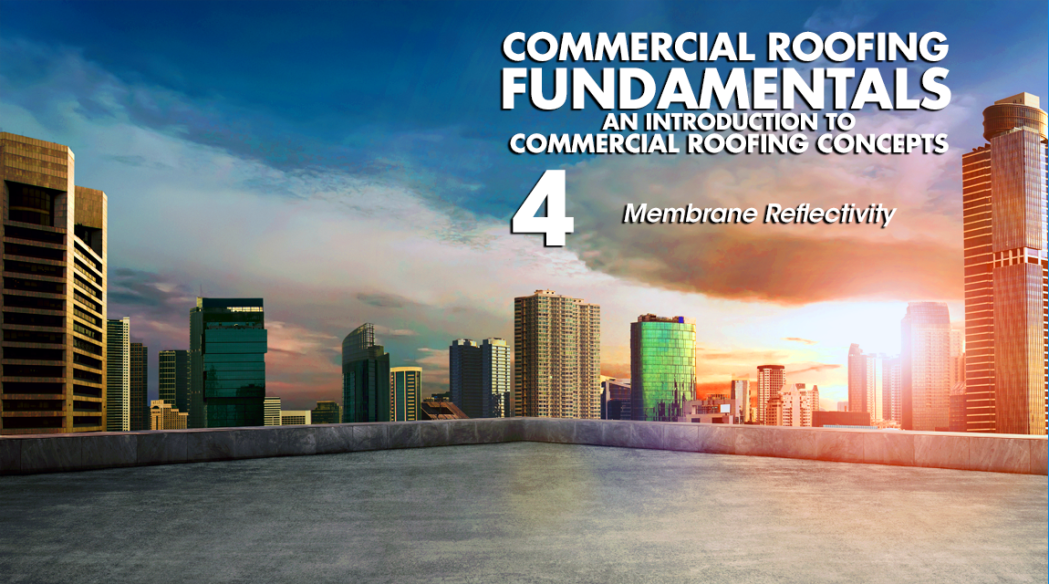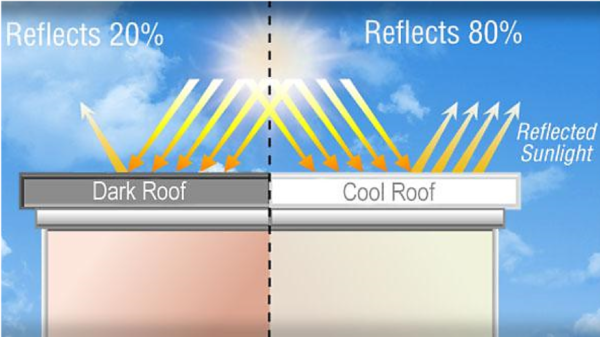CRF 4: membrane reflectivity

By Don Kilcoyne , GAF.
Use of cool reflective roofs can save $735 million in annual energy costs and reduce pollutants.
In this installment, the GAF ProBlog continues a series called Commercial Roofing Fundamentals. As an introduction to commercial roofing, the series provides an overview of some of the key concepts that are driving industry decision-making.
Membrane Reflectivity
The basic premise of reflective roofing is simply that a reflective roof will reduce the heat load on a building and thereby reduce the amount of air conditioning used. Of course, actual energy savings may vary based on a number of factors like climate zone, utility rates, etc.

Why is this important? A study conducted by the Lawrence Berkley National Laboratory, and reported in The New York Times, suggests that retrofitting 80% of U.S. air-conditioned commercial buildings with reflective (cool) roofs would save enough on air-conditioning costs to:
- Save $735M annually
- Eliminate:
- 2 metric tons of CO2 emissions — the equivalent of 1.2 million cars
- 9 Kilo Tons nitrogen oxides, NOx — the output of 600,000 cars
- 26 kilo tons SO2 — a key component of acid rain
- 126 kilograms Mercury (via lowered coal usage for energy generation)
Before exploring these claims further, which we will do in future posts, it’s important to understand a few concepts, metrics, and standards involved in cool roofing.
- The first concept, reflectivity, is a measure of how much solar energy is reflected by the membrane. It is expressed as Solar reflectance – SR. Measured on a scale of 0 to 1, 0 means all solar light and heat is absorbed, while 1 means 100% of solar light and heat are reflected away.
- Emittance describes how much absorbed heat is radiated back into the atmosphere. Also measured on a scale of 0 to 1, 0 means that the membrane doesn’t radiate any of the absorbed heat back to the atmosphere (i.e. the membrane heats up) while 1 means all absorbed heat is radiated back (i.e. the membrane doesn’t heat up).
- The Solar Reflectance Index (SRI) is a measure of the roof’s ability to reject solar heat. Defined so that a standard black (reflectance 0.05, emittance 0.90) is 0 and a standard white (reflectance 0.80, emittance 0.90) is 100. It’s measured as the temperature rise of a material compared to the standard black and white materials.
- Energy Star is a voluntary labeling program for energy efficient products. To receive Energy Star designation, low slope roofing must have a minimum SR of 0.65.
- ASHRAE 90.1 Energy Standard for Buildings Except Low-Rise Residential Buildings includes the energy-saving benefits of cool roofs separate from roof insulation. ASHRAE 90.1 is referenced by some state/city energy codes and defines cool roofs as having a minimum solar reflectance of 0.70 and a minimum thermal emittance of 0.75.
- California Title 24 Standards sets mandatory energy efficiency standards for all new building construction, additions, and renovations in California. Title 24 cool roof requirements were derived from ASHRAE 90.1.
- The Cool Roof Ratings Council, CRRC, publishes initial and three year field aged SR and emittance data for all roofing products registered with them. The data is obtained independently via a strict accreditation program administered by CRRC. Three year aged data represents long term values. It is obtained by actual outdoor exposure at a CRRC site. For example, typical values for new and aged TPO are shown here:

Cool Roof Exemptions
- In some regions, buildings are considered exempt from cool roof requirements if either of the following applies:
- There is a photovoltaic, or solar system installed
- There is a green roof
It is important to understand the specifics of each in terms of area of the roof impacted by either solar arrays or green “vegetative” installations. Always check with local code officials.
To learn more about GAF visit here.
Source: GAF.





















Comments
Leave a Reply
Have an account? Login to leave a comment!
Sign In